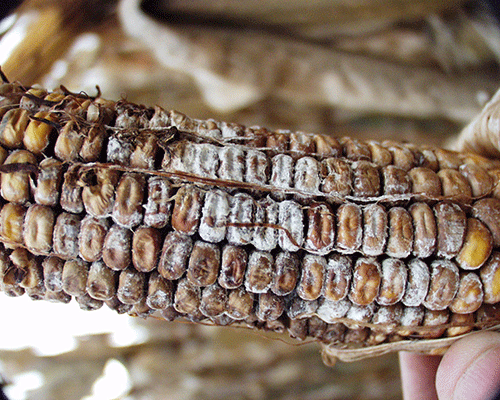Preventing vomitoxin
TIPS FOR A HEALTHY CORN CROP

VOMITOXIN (ALSO KNOWN as deoxynivalenol (DON)) can severely compromise the quality of a corn crop, limiting both its use and value. In 2016, the annual vomitoxin survey to assess the presence of corn ear mould and grain vomitoxin, conducted by the Ontario Ministry of Agriculture, Food and Rural Affairs (OMAFRA) field crops team, confirmed the concerns being raised by many farmers.
“Overall, there has been little DON in recent years, but levels fluctuate, and there are always hot spots where we see elevated levels,” says Albert Tenuta, OMAFRA field crops pathologist. “2016 was a year with some concerns — it wasn’t an epidemic type year like we saw in 2006 and 1996, but there was substantially more mycotoxins and DON present than in previous years.”
Mycotoxin and DON levels were elevated in 2016 due to hot, dry conditions that resulted in stressed plants and incomplete pollination. Incomplete pollination sets the stage for later infection to occur by leaving open ear tips. Although weather was hot and dry through most of the province, unpollinated ear tips were sprouting, indicating good moisture levels, a prime opportunity for ear moulds to develop.
“These conditions aren’t often seen, but mycotoxins are always good at taking advantage of whatever conditions exist,” says Tenuta. “Depending on the area and conditions, Western Bean Cutworm can also be a factor — mycotoxin levels were very high in some cases with little mould. There is no one case for every situation.”
RISK FACTOR MANAGEMENT
Mycotoxins are a product of mould, which is created from infection. Therefore, a good rule of thumb is no disease equals no mould. However, mould does not necessarily need to be visible to be present. Giberella is the most important mould with regards to ear mould and ear rot. Not only does a Giberella contamination decrease yield and grain quality, it can also develop into DON.
Heavy dews, leaf wetness, silk wetness, incomplete pollination, as well as stress through environmental factors such as drought, heat, cold, and pests play an important role in the formation of mould. Disease such as Northern corn leaf blight and stalk rot can also open the door to a Giberella infection.
“When the plant is under stress, whether that’s from weather conditions, insect damage, or disease, it’s at risk for developing an infection which can create mould,” says Tenuta. “The goal is to decrease stress and promote healthy growing.”
“It’s critical that growers are out there scouting pre-pollination and pre-harvest; pre-pollination to decide on fungicide applications and pre-harvest to determine which ear rots are present and if they produce mycotoxins.”
When it comes to harvest and storage, grain should be carefully managed to prevent further contamination. A timely harvest, appropriate combine adjustments, lower moisture (15% moisture or less), and quick cooling time can prevent the deterioration of grain. Once corn is dried to 15% moisture or less, the mycotoxin risk or further development of an infection is decreased. If a field is contaminated, growers should harvest infected fields first, segregate the grain; and then have it tested.
Grain will never improve in storage, but it is possible to maintain quality. In milder conditions, the grain bin needs to be aerated to prevent the formation of moulds and potential mycotoxins. DON levels should be tested both in the field and in storage, says Tenuta.
PREVENTING AN INFECTION
Preventing DON begins before the season has begun, says Tenuta. Growers need to do all they can to promote a healthy growing season, and ensure plants don’t experience nutrient stress, soil stress, or insect stress.
Planning ahead, especially in hot spots or in fields with a history of mycotoxin contamination, is crucial in preventing or reducing infection risk. Growers should choose hybrids that have a decreased susceptibility to ear mould, good lodging tolerance, and are resistant to leaf/stalk rot diseases.
“Growers need to select the best hybrid for their field,” says Tenuta. “We’re doing a better job with hybrid development in terms of tolerance and definitely moving in the right direction, but we’re not there yet. Selecting a variety that is resistant to leaf diseases is a good strategy for growers.”
Tenuta says in-season fungicides can also be used, but only alleviate some of the pressure, they do not eliminate mould. However, there is a limited number of fungicides that may be applied that are effective on ear rot.
“The best way growers can prevent vomitoxins in their grain is to choose the best hybrids for their field and keep plants free of stressors such as having good nitrogen levels, healthy soil, and good fertility.” •

























